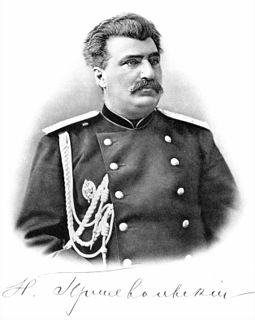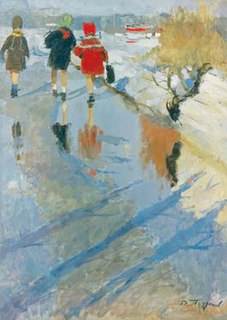Related Research Articles

The Museum of Jurassic Technology at 9341 Venice Boulevard in the Palms district of Los Angeles, California, was founded by David Hildebrand Wilson and Diana Drake Wilson in 1988. It calls itself "an educational institution dedicated to the advancement of knowledge and the public appreciation of the Lower Jurassic", the relevance of the term "Lower Jurassic" to the museum's collections being left uncertain and unexplained.

Nikolay Mikhaylovich Przhevalsky was a Russian Imperial geographer and a renowned explorer of Central and East Asia.

Ivan Konstantinovich Aivazovsky was a Russian Romantic painter who is considered one of the greatest masters of marine art. Baptized as Hovhannes Aivazian, he was born into an Armenian family in the Black Sea port of Feodosia in Crimea and was mostly based there.

Valentin Alexandrovich Serov was a Russian painter and one of the premier portrait artists of his era.

The Empire Nephrite egg is a jewelled Easter egg, purported to be one of the Imperial Eggs made under the supervision of the Russian jeweller Peter Carl Fabergé in 1901–1902 for Nicholas II of Russia, who presented it to his mother, the Dowager Empress Maria Feodorovna, at Easter 1902. This provenance has been challenged by some Fabergé experts.

Hagop Sandaldjian (1931–1990) was an Egyptian-born Armenian American musician and microminiature sculptor, best known for his tiny art pieces displayed at the Museum of Jurassic Technology in Los Angeles, California. Sandaldjian's creations included a carving of Mount Ararat on a grain of rice; a crucifix in which a minute golden figure of Jesus hangs upon a cross made from a bisected strand of Sandaldjian's own hair; and recreations of Disney figures or historical figures presented in the eye or on the tip of a needle.

The Rock Crystal egg or Revolving Miniatures egg is an Imperial Fabergé egg, one in a series of fifty-two jeweled eggs made under the supervision of Peter Carl Fabergé for the Russian Imperial family. It was created in 1896 for Empress Alexandra Feodorovna. The egg currently resides in the Virginia Museum of Fine Arts.

The Dowager Fabergé egg, is a jewelled Easter egg made under the supervision of the Russian jeweller Peter Carl Fabergé in 1898. The egg was made for Nicholas II of Russia, who presented it to his mother, the Dowager Empress Maria Feodorovna on Easter 1898.

The Red Cross with Triptych egg, also known as Red Cross Triptych egg or Red Cross Egg with Resurrection Triptych, is an enameled Easter egg made under the supervision of the Russian jeweler Peter Carl Fabergé in 1915, for Nicholas II of Russia. Nicholas II presented the Fabergé egg to his wife Empress Alexandra Fyodorovna on Easter 1915.

Nikolai Efimovich Timkov was a Soviet Russian painter, Honored Artist of Russian Federation, and a member of the Saint Petersburg Union of Artists. He lived and worked in Leningrad and is regarded as one of the leading representatives of the Leningrad School of Painting, worldwide known for his landscape paintings.

Sudarsan Pattnaik is an Indian Sand Artist from Puri, Odisha. In 2014, Government of India honoured him with the Padma Shri, India's fourth-highest civilian award, for his amazing and wonderful sea shore sand arts.

Nikolai Ivanovich Kostrov was a Russian Soviet painter, graphic artist, and illustrator, who lived and worked in Leningrad. He was a member of the Leningrad Union of Artists, and regarded as one of representatives of the Leningrad school of painting and graphics.

Anatoly Ivanovich Konenko is a microminiature painter and sculptor from the Russian city of Omsk. In 1996 he was entered into the Guinness Book of World Records for creating the world's smallest book.

Cornflowers is a painting by the Russian artist Sergei Ivanovich Osipov (1915–1985), executed in 1976 and related to his most famous works in the genre of still life.

Spring Day (Russian: Весенний день is a painting by Russian artist Nikolai Matveevich Pozdneev. It attempts to convey the mood of Soviet society of the late 1950s to the early 1960s.

Nikolai Markarov Soviet Russian artist and sculptor.

Graham Short, is a micro-artist, living and working in Birmingham, England.

Nikolai Aleksandrovich Mukhin is a Soviet and Russian iconographer and sculptor. Mukhin is member of the Russian Academy of Arts and People's Artist of the Russian Federation. He established an icon art colony in his hometown of Yaroslavl. His main works are the frescos of the Cathedral of Christ the Saviour in Moscow and his principal work on the mosaics in the Church of Saint Sava in Belgrade, which after completion will form the biggest mosaic ensemble ever executed.

Nikolay Nikolaevich Sednin is a Russian painter, founder of Di-Art and the Heliography style, writer, art historian, public figure. General Director of the Professional Union of Artists of Russia, Academician of the Russian Academy of Art Criticism, Chairman of the Editorial Board of the ELITARCH National Award, Chairman of the jury of the international competition Art. Excellence. Awards, chief production designer of the Moscow theater "Avalon Ars Terra" , Honored Artist of Russia, Honorary President of the International Academy of Contemporary Arts (2019), People's Writer of Russia, Doctor of Arts.
Mosconcert is the oldest cultural organization in Moscow. Its full name is "Mosconcert, state budgetary institution of culture of Moscow"
References
- ↑ "Microminiature Art". TIME . August 11, 2008. Archived from the original on August 23, 2008. Retrieved May 20, 2010.
- 1 2 "See what will fit on a grain of ricework". Dziennik Polska-Europa-Świat .
- ↑ "Art So Small You Need a Microscope". The Moscow Times . November 28, 2003.
- ↑ "When the camel through the eye of a needle". Xinhua News Agency .
- ↑ "Medvedev will visit the Armory in the Kremlin of Tula". RIA Novosti .
- 1 2 "Want to visit a museum? Take a magnifying glass!". RT (TV network) .
- ↑ "Miniature museum to open". Moscow News .